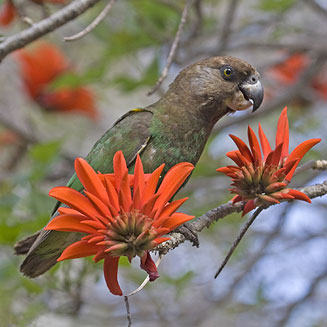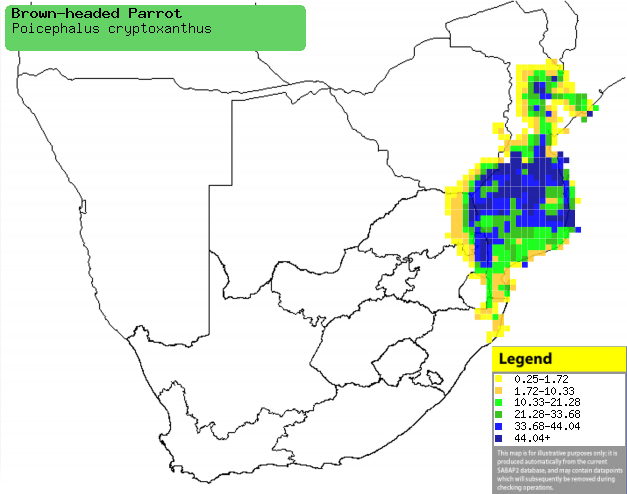|
Poicephalus cryptoxanthus
(Brown-headed parrot)
Bruinkoppapegaai [Afrikaans]; Yhokwe [Tsonga];
Bruinkoppapegaai [Dutch]; Perroquet à tête brune [French]; Braunkopfpapagei
[German]; Papagaio-de-cabeça-castanha [Portuguese]
Life
> Eukaryotes >
Opisthokonta
> Metazoa (animals) >
Bilateria >
Deuterostomia > Chordata >
Craniata > Vertebrata (vertebrates) > Gnathostomata (jawed
vertebrates) > Teleostomi (teleost fish) > Osteichthyes (bony fish) > Class:
Sarcopterygii (lobe-finned
fish) > Stegocephalia (terrestrial
vertebrates) > Tetrapoda
(four-legged vertebrates) > Reptiliomorpha > Amniota >
Reptilia (reptiles) >
Romeriida > Diapsida > Archosauromorpha > Archosauria >
Dinosauria
(dinosaurs) > Saurischia > Theropoda (bipedal predatory dinosaurs) >
Coelurosauria > Maniraptora > Aves
(birds) >
Order: Psittaciformes > Family: Psittacidae
 |
 |
|
Brown-headed parrot, Mpumalanga, South Africa. [photo
Neil Gray
©] |
Brown-headed parrot, Lower Sabi, Kruger National
Park, South Africa. [photo Johann Grobbelaar
©] |
The Brown-headed parrot occurs in woodlands from east Africa
through to Mozambique and northern KwaZulu-Natal. It feeds mainly on fruit and seeds, with the rest of its
diet largely made up of Lepidoptera larvae and tree shoots. It nests in old
woodpecker holes in trees, laying 2-4 eggs from April-May in South Africa.
Incubation is done solely by the female, with the male doing the foraging. The
chicks are fed only by the male, but always with the female present. The brood
stay in the nest for 50-54 days before leaving for a "nursery area", where they
stay for 28 days before becoming fully independent.
Distribution and habitat
Occurs from southern Kenya and Tanzania to Malawi,
Mozambique, south-eastern Zimbabwe and eastern South Africa. It generally
prefers open woodland with fruit or
seed-bearing trees, especially Knob thorn (Acacia
nigrescens) and Mopane (Colosphermum mopane). It occasionally moves
into mangroves, but avoids sparsely wooded savanna and dense
woodland.
|
 |
|
Distribution of Brown-headed parrot in southern Africa,
based on statistical smoothing of the records from first SA Bird Atlas
Project (©
Animal Demography unit, University of
Cape Town; smoothing by Birgit Erni and Francesca Little). Colours range
from dark blue (most common) through to yellow (least common).
See here for the latest distribution
from the SABAP2. |
Predators and parasites
- Parasites
- Protolichus megamerus (feather mite)
- feather lice
- Mimemammenopon zumpti (only found on the Brown headed parrot)
- Psittacomenopon impar
- Neopsittaconirmus africanus
Food
Its diet varies greatly in different regions, doing most of
its foraging in tree canopies, grabbing food with its bill. The following food items have been recorded
in its diet:
- Plants
- seeds
- Cassia abbreviata (Long-tail Cassia)
- Erythrina lysistemon (Sacred coral tree)
- Trichilia emetica (Forest Natal-mahogany)
-
Acacia nigrescens (Knob thorn)
-
Acacia tortilis (Umbrella thorn)
- Albizia gummifera (Smooth-bark flat-crown)
- Eucalyptus grandis (alien Saligna gum)
- fruit
- Combretum (Bushwillow)
- Terminalia (Cluster-leafs)
- Diospyros mespilliformes (Jackal-berry)
- Ficus sycomorus (Sycomore fig)
- Kirkia acuminata (White kirkia)
- Lannea schweinfurthii (False-marula)
- Mystroxylon aethopicum (Kooboo-berry)
- Manihot esculenta (alien Cassava)
- Strychnos (Monkey-orange)
- flowers
- Erythrina lysistemon (Sacred coral tree)
- Trichilia emetica (Forest natal-mahogany)
- Cocos nucifera (Coconut)
- nectar of Aloe marlothii (Mountain Aloe)
- green shoots of trees
- Insects
Breeding
- It typically nests in old tree holes of woodpeckers, 4-10m above
ground. It often has to compete with
Grey-headed parrots, Meyer's parrots,
squirrels and hornbills for nesting
sites.
- Egg-laying season is from April-May in South Africa. (other laying dates
unknown)
- It lays 2-4 eggs, which are incubated solely by the female for 26-30 days, while
the male feeds her at the nest.
- The chicks are fed only when both adults are present, who first clean
the nest before handing over the food.
- The chicks stay in the nest for 50-54 days before leaving for the
'nursery area', which usually is an area with densely leaved trees with
water nearby. During this time the chicks are silent and largely immobile,
becoming fully independent about 28 days later.
Threats
Not threatened, although its distribution has contracted
since 1990, largely due to illegal trapping for the cage bird industry.
References
-
Hockey PAR, Dean WRJ and Ryan PG (eds) 2005. Roberts
- Birds of southern Africa, VIIth ed. The Trustees of the John Voelcker
Bird Book Fund, Cape Town.
|
